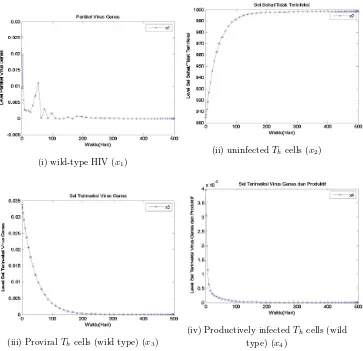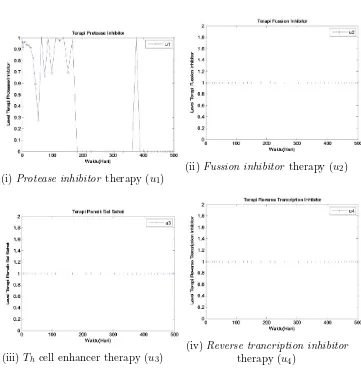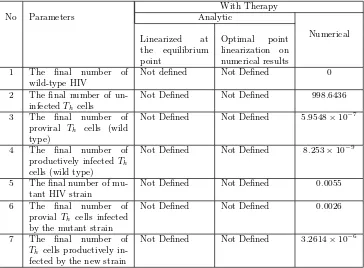THE SIMULATION OF CONTROLING THE
SPREAD OF HIV USING ANALYTICAL
AND NUMERICAL APPROACH
Miksalmina, Said Munzir and Tarmizi
Abstract.This research is related to the optimal control problem in controlling the
spread of HIV (Human Immunodeficiency Virus) to minimize the amount of HIV virus and treatment costs. The solution of the problem in this is conducted by the analytical and numerical approaches. The solution is initially conducted analytically through linearization of state equations around equilibrium point, while the second solution is conducted numerically using the direct discretization method with pseu-dospectral approach. The analytical solution procedure using Pontryagin Minimum Principle with the help of MATLAB symbolic features, while numerical solution us-ing Gaus Pseudospectral Method (GPM) with the help of TOMLAB/PROPT. The results of numerical simulations for controlling the spread of the HIV virus to the initial timet0= 0and the final timetf = 500successfully minimize mutant HIV
strain, proviral Th cells infected by the mutant strain , and Th cells productively infected by the new strain as well as minimizing the cost of therapy is needed. The optimal solution indicates an increase in uninfected Th cells and a decrease in wild-type HIV, proviral Th cells (wild wild-type), productively infected Th cells (wild wild-type), mutant HIV strain, proviral Th cells infected by the mutant strain and Th cells pro-ductively infected by the new strain. These results showed a significant difference with the analytical solution. There are many potential differences in the results, including as a result of linearization at the equilibrium point and the condition number for the matrix involved in the analytic solution.
Received 11-12-2014, Accepted 12-05-2015.
2010 Mathematics Subject Classification: 30C45
Key words and Phrases: HIV, Optimal Control, Pontryagin Minimum Principle, Gauss Pseu-dospectral Method (GPM)
1. INTRODUCTION
Acquired Immuno Deficiency Syndrome (AIDS) is an infectious disease caused by a virus called Human Immuno Deficiency Virus (HIV). HIV (Hu-man Immunodeficiency Virus) is a virus that attacks the hu(Hu-man immune system. This disease is a dangerous disease and should be aware because it spread rapidly around the world [9]. One approach for explaining the solution of the problems of the spread of the HIV virus that occur in the real world is to translate the problem into mathematical language
According to Setiawan [9], by translating problems into mathematical language it will obtain a mathematical models, which describe the results of the formulation of the problem to be solved. Mathematical models can be applied to determine the spread of the HIV virus. The purpose of modeling is to control the spread of the HIV virus where its complexity tends to increase.
Various attempts were made to control the spread of the HIV virus. One of them is the solution of drug therapy. Fariana [4] have conducted an analysis of stability and optimal control of drug therapy in the treatment of HIV with Highly Active Anti-Retroviral Therapy (HAART). HAART is a method of treatment which is performed in patients with HIV that aims to slow the progres of HIV infection to AIDS.
Research results show the effectiveness of drug control to suppress the development of the HIV virus with the provision of Anti Retroviral Drugs (ARVs). ARV is a drug that works inhibit HIV replication in CD4 (white blood cells), so as to reduce the amount of virus in the blood.
The results of two studies conducted by Fariana [4] and Sukokarlinda, et al (2013) provide a solution that is not optimal. This is due to HAART and the provision of antiretroviral drugs can not eliminate the life cycle strains (strains) of HIV in a population vary widely and can cause serious side effects. Therefore, it is necessary to control the spread of HIV in other ways.
Stengel [11] has conducted a simulation control of HIV by developing a model of Perelson, et al [1] and Kirschner, et al [3] in the form of four dynamic equations. This model was then developed into seven dynamic equations which describe some therapies as the treatment.
The model is solved by analytical and numerical approaches. Analytic ap-proach is solved with the help of MATLAB symbolic, while the numerical approximation is solved with the helping TOMLAB/propt.
2. METHODS
Research activities include study design, study subjects, research pro-cedures and research instruments. The design of the research conducted in this research is to collect research materials including sources of informa-tion both journals, books articles and other relevant instrucinforma-tions. In this case study refers to internasionl journal entitled Mutation and control of the human immudeficiency virus written by Robert F. Stengel [11]. In this case study refers to internasionl journal entitled Mutation and control of the human immudeficiency virus written by Robert F. Stengel [11]. The journal reference used is a journal with the title Dynamics of HIV infection of CD4+T Cells by Perelson [1] and Optimal control of the chemotherapy of HIV by Kirschner [3] and Strategy Control the spread of HIV wild type and mutant therapy with inhibitors by Afandi [2]. The subject of research in this paper is to analyze the results Stengel [11] using simulation TOM-LAB/propt. Besides understanding the theories that support the discussion of optimal control problems that include: Pontryagin Minimum Principle, Gauss Pseudospectral Method (GPM), the program TOMLAB/propt and symbolic methods.
Troubleshooting control the spread of HIV in this study through an-alytical and numerical approaches. anan-alytical solution performed with lin-earized equation of state around the equilibrium point with the help of MATLAB symbolic. While the settlement is done numerically by direct discretization using pseudospectral method with the help TOMLAB/propt. Simulations done with therapy and no therapy for optimal control problems in controlling the spread of HIV is done with the initial time t0 = 0 and the final time tf = 500, the value of the control variable for
therapyu1, u2, u3, u4 ranges between 0 and 1. Simulation is done to control the spread of HIV processing time for 500 days.
Simulations are also carried out with a view to minimizing the number of objective function the mutant HIV strain (x5), proviralTh cells infected
by the mutant strain (x6), and Th cells productively infected by the new
strain (x7) as well as the cost of therapy. While the control variable is therapyprotease inhibitor (u1),fussion inhibitor (u2),Th cell enhancer (u3)
the parameter initial values of the state variables are different, using the parameter values of the journal Stengel [11].
3. RESULTS
Dynamic system used in this study consisted of seven differential equa-tions, each of which express a mathematical model consisting of : wild-type HIV, uninfectedThcells, proviral Th cells (wild type), productively infected
Th cells (wild type), mutant HIV strain, proviral Th cells infected by the
mutant strain andTh cells productively infected by the new strain. System
of differential equations describe the spread of the HIV virus and the type of therapy as control variables are given by the following dynamical system [11]:
˙
x1 = a1x1−a2x1x2(1−u2) +a3a4x4(1−a10)(1−u1)
˙
x2 = a5
1 +x1+x5
−a2x1x2(1−u2)(1−u4)−a6x2−a2a11x2x5
+a7 1−
x2+x3+x4+x6+x7 a8
x2(1 +u3)
˙
x3 = a2x1x2(1−u2)(1−u4)−a9x3−a6x3 ˙
x4 = a9x3−a4x4
˙
x5 = a3a4a10x4+a3a4x7−a1x5−a2a11x5x2 ˙
x6 = a2a11x5x2−a9x6−a6x6 ˙
x7 = a9x6−a4x7 (1)
˙
x4 = Productively infectedTh cells (wild type)
˙
x5 = Mutant HIV strain ˙
x6 = ProviralTh cells infected by the mutant strain
˙
x7 =Th cells productively infected by the new strain
a1 = The average particle death
a2 = Constant average healthy cells become infected a3 = The amount of HIV virus produced
a4 = Average mortality ˙x4 a5 = Sources of healthy cells a6 = Average mortality ˙x1 and ˙x3 a7 = The average growth of healthy cells a8 = The maximum level of healthy cells
a9 = Average of infected cells become productive a10 = The mutation rate
a11 = The mutant strain has a fitness u1 = Protease inhibitor
u2 = Fussions inhibitor u3 =Th cells enhancer
u4 = Reverse trancription inhibitor
System of differential equations (1) above is referred to as equation of state (state equation). Each differential equations dynamical systems above have the initial conditions and final time (tf) is determined. Fix In this
study, variations in circumstances that meet the type of control system
ed-final time and free-ed-final state system, wherex(t0) =x0 danx(tf) =xf free.
Optimal Control Solution
Where the value of u is taken from the set u, u∈U ={u(t)|0≤u ≤
1,0 ≤t ≤tf}. In this case, u as (0 ≤ u ≤ 1) is a measure of the medical
business (with the upper limit of 1 and the rate of medical efforts made proportionally from the amount of HIV virus). Equation (2) shows r is a variable that is correlated with weight control usage costs (cost control) is a balancing factor of cost control system. whereasSf55, Sf66, Sf77, q55, q66, q77 is a diagonal matrix elements are presented in equation (2) which states that permitted reciprocal relationship between the values of the response to the charges, with the aim of balancing the speed and efficacy of treatment, in this case will look for a minimum function.
Analytical methods
Optimal treatment strategy is obtained by solving the optimality system, consisting of fourteen ordinary differential equation of state and costate equations. The settlement resolved by designing a symbolic program MAT-LAB, by first linearized seven state equation.
1. Around Equilibrated point linearization
To liniarized seven state equation then determined equilibrium point, where x∗
1 = x∗3 = x∗4 = x∗5 = x∗6 = x∗7 = 0, x∗2 = 1000 and assumed u∗
1 = u∗2 = u∗3 =u∗4 = 0 thus obtained form a linear system. By using the Taylor series approach the equation system around the equilibrium point is
F(x, u) =f(x∗
Based on the equation (3) above obtained results linearized state equation as
dx1
Results linearization of equation (4) above, then solved using Pontrya-gin minimum principle with the help of MATLAB symbolic program, in order to obtain the general solution of the homogeneous and non- homoge-neous equations. Final solution of this problem is obtained as follows:
x∗
Of the general solution can chart of satay and control variables are presented in Figure 1 and Figure 2 as follows:
Figure 1 shows that the number of wild-type HIV, uninfectedTh cells,
proviralTh cells (wild type), productively infectedTh cells (wild type),
mu-tant HIV strain, proviral Th cells infected by the mutant strain and Th cells
productively infected by the new strain.
Figure 2 shows the therapy ofprotease inhibitor, fussion inhibitor,Th
cells enhancer, reverse trancription inhibitor is static. It indicates that the four therapeutic fixed and unchanged.
2. Linearization point Optimal Numerical Results
In this case, the point of which is used for seven linearized state equation that the optimal point TOMLAB results, where x∗
1 = 0.001988, x∗
2= 983.68099, x∗3 = 0.00568, x∗4 = 0.00025, x∗5 = 0.007212,x∗6 = 0.003196, x∗
F(x, u) = f(x∗
determined value symbolic constants with the help of the program. Final solution of this problem is obtained as follows:
˙
Of the general solution can chart of state and control variables are presented in Figure 3 and Figure 4 as follows:
Figure 3 shows that the proviralTh cells and productively infectedT h
Figure 3: Analytical Solutions At state variables On Optimal Point Numer-ical Results
Table 1: Initial Condition Variable State [11]
Parameters Value Estimates
x1 0.049
x2 904
x3 0,034
x4 0,0042
x5 0
x6 0
x7 0
a1 2,4
a2 0,000024
a3 1200
a4 0,24
a5 10
a6 0,02
a7 0,03
a8 1500
a9 0,003
a10 0.1
a11 0,6
Numerical Simulation and Analysis of Results
Completion of optimal control problems controlling the spread of the HIV virus using the direct method is based on the transformation of the optimal control problem into a problem of Non Linear Programming (NLP) with the state equation and the equation discretization control using pseu-dospectral method. Problem solving optimal control the spread of the HIV virus is done by using propt-MATLAB Optimal Control Software is TOM-LAB/propt Optimization, which run on MATLAB software 7.10.0 (R2010a) is a toolbox that implements the method parameterization approach control variables that can be used to solve the NLP problem.
To be able to perform simulations of optimal control problems control-ling the spread of the HIV virus by using TOMLAB/propt, required values of the parameters of the dynamic system models are presented in Table 1.
into the program TOMLAB/propt thus obtained simulation. Simulation for optimal control problems spread of the HIV virus carried by the initial time t−0 = 0 and final time tf = 500 , the value of the control variable for
therapy u1, u2, u3, u4 ranges between 0 and 1 Simulations performed with the initial value 1 = u2 =u3 =u4 = 1 and the level of resistance mutants a11= 0.6.
Figure 5. (i) indicates that the population of malignant viral particles decreases from the maximum point of 0.0253 to the minimum point 0 so achieve stability until day 500. Figure 5. (ii) shows that the number of healthy cells / uninfected Increased to 998.6436. Figure 5. (iii) indicates that the number of malignant virus-infected cell population plummeted to about 200 days, and then tended to be stable until day 500. Figure 5. (iv) shows that the number of malignant viruses and productive population also decreased to about 100 the first day, then tended to be stable until day 500. Figure 5. (v) shows that the population of mutant viral particles tended to decrease from the maximum point of 0.0228 towards 0.0055 minimum point. Figure 5. (vi) shows that the number of mutant virus-infected cell popula-tion experienced a steady increase until the first 100 days, then decreased gradually until day 500 by 2.6×103.
Figure 6. (i) indicates that the protease inhibitor therapy in the form of bang-bang (control function experienced a jump between 0 and 1) and fluctuated from 1 to the maximum point of the minimum point 0 and back again to the point of maximum 1. This indicates the power of therapy in suppressing and controlling cell growth of the HIV virus, thus toward equilibrium. While Figure 6. (ii), 6. (Iii) and 6 (iv) shows in a static state, meaning fussion inhibitor therapy, therapy riser healthy cells and reverse trancription inhibitor therapy fixed and unchanged. This indicates the power of therapy in controlling the growth of the HIV virus so that in a static state.
4. CONCLUSIONS
Simulation results Simulation analytic linearization equilibrium point is not defined on the results wild-type HIV, uninfected Th cells , proviral
Th cells (wild type), productively infectedTh cells (wild type), mutant HIV
strain, proviral Th cells infected by the mutant strain and Th cells
produc-tively infected by the new strain. While the optimal linearization point numerical results also provide results not defined, except in proviralThcells
(i) wild-type HIV (x1)
(ii) uninfectedThcells (x2)
(iii) Proviral Thcells (wild type) (x3)
(iv) Productively infectedThcells (wild type) (x4)
(i)Protease inhibitor therapy (u1)
(ii)Fussion inhibitor therapy (u2)
(iii)Th cell enhancer therapy (u3)
(iv)Reverse trancription inhibitor
therapy (u4)
Table 2: Comparison of Simulation Results Without Therapy and the Treat-ment
No Parameters
With Therapy Analytic
Numerical Linearized at
the equilibrium point
Optimal point linearization on numerical results 1 The final number of
wild-type HIV
Not defined Not Defined 0
2 The final number of un-infectedThcells
Not Defined Not Defined 998.6436
3 The final number of proviral Th cells (wild type)
Not Defined Not Defined 5.9548×10−7
4 The final number of productively infectedTh cells (wild type)
Not Defined Not Defined 8.253×10−9
5 The final number of mu-tant HIV strain
Not Defined Not Defined 0.0055
6 The final number of provial Th cells infected by the mutant strain
Not Defined Not Defined 0.0026
7 The final number of Thcells productively in-fected by the new strain
of numerical simulations for controlling the spread of the HIV virus to the initial timet0= 0 and the final time tf = 500 successfully minimize mutant
HIV strain (x5), proviral Th cells infected by the mutant strain (x6), and Th cells productively infected by the new strain (x7) as well as minimizing
the cost of therapy is needed. The optimal solution indicates an increase in uninfected Th cells and a decrease in wild-type HIV, proviral Th cells
(wild type), productively infected Th cells (wild type), mutant HIV strain,
proviralTh cells infected by the mutant strain andTh cells productively
REFERENCES
References
[1] A.S. Perelson, D.E. Kirschner, and R.J. DeBoer. 1993.Dynamics of HIV infection of CD4+ Tcells,Math. Biosci.114: 81.
[2] Afandi, M. Zainul. 2011. The spread of HIV Control Strategy Type and Mutant Threatening with Inhibitor Therapy,Journal of Social
Human-ities.1: 117-130.
[3] D.E,Kirschner,Suzanne Lenhart, and Steve Serbin.1997. Optimal con-trol of the chemotherapy of HIV,Journal of Mathematical Biology. 35: 775-792.
[4] Fariana, Pitut. 2012. Stability Analysis and Optimal Control on Drug
Therapy in HIV treatment. Thesis. ITS, Surabaya.
[5] Jennings, L.S., M.E. Fisher., K.L. Teo., and C.J. Goh. 2002. Miser 3
Optimal Control Software: Theory and User Manual. Version 2.0.
De-partment of Mathematics The University of Western Australia, Ned-lands.
[6] Landi, A., Mazzoldi, A., Andreoni, C., Bianchi, M., Cavallini, A., Lau-rino, M.Ricotti, L., Iuliano, R., Matteoli, B., and Nelli, L.C. 2008. Modelling and control of HIV dynamics, Computer methods and
pro-gram in biomedicine. 89: 162-168.
[7] Mhawej, M.J., Moog, C.H., Biafore, F., Francois, C.B. 2010. Control of HIV infection and drug dosage, Biomedical Signal Processing and
Control. 5: 45-52.
[8] Naidu, D.S. 2003. Optimal Control Systems, CRC PRESS, New York.
[9] Notoatmodjo, S. 2012. Public Health Science and Art. Rineka Cipta. Jakarta.
[10] Rutquist, E.Per and M.Edvall, Marcus. 2010.TOMLAB/PROPT
Op-timization, Propt-Matlab Optimal Control Software, Sweden. Critical
Behavioral Assumptions in Evacuation Time Estimate Analysis for Pri-vate Vehicles: Examples from Hurricane Research and Planning.
[11] Stengel, R.F. 2008. Mutation and control of the human immunodefi-ciency virus,Mathematical Bioscienses. 213: 93-102.
[12] T. Huntington, Geoffrey,. And Anil V.Rao. 2005. Optimal Configura-tion of Spacecraft Formalitas Via A Gauss Pseudospectral Method. The Charles. Tesis. Stark Draper Laboratory, Inc.
Miksalmina: Mathematics Graduate Study Program, Syiah Kuala University, Banda Aceh-Indonesia
Said Munzir: Mathematics Graduate Study Program, Syiah Kuala University, Banda Aceh-Indonesia
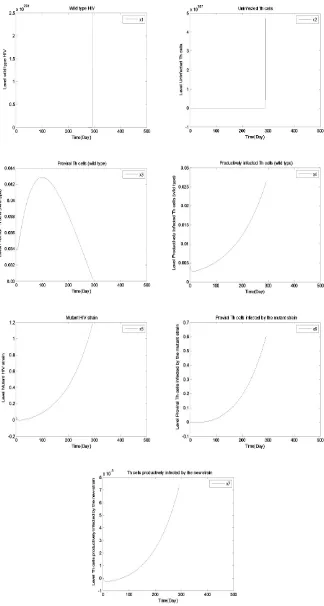

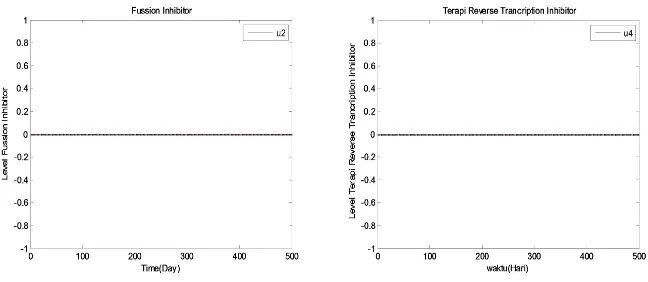
![Table 1: Initial Condition Variable State [11]](https://thumb-ap.123doks.com/thumbv2/123dok/3550014.1778815/14.595.163.433.132.404/table-initial-condition-variable-state.webp)
